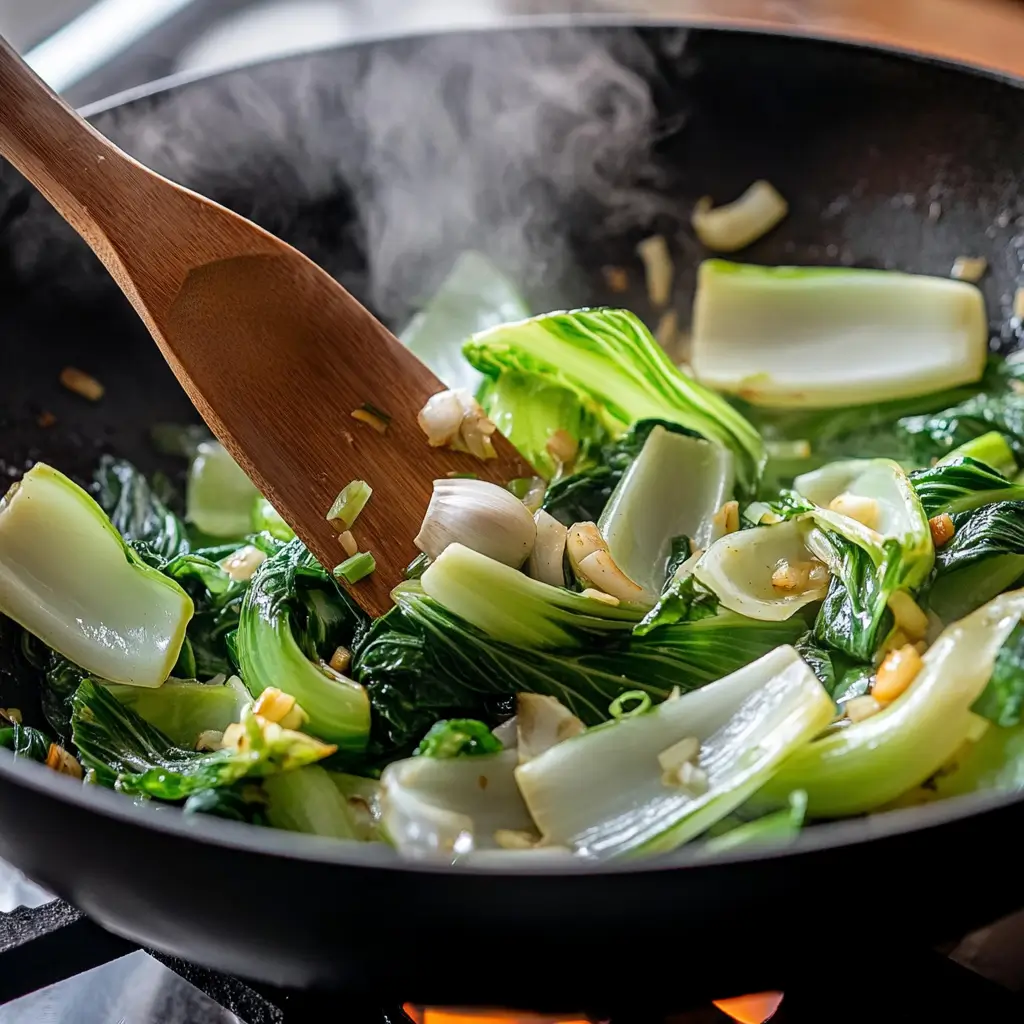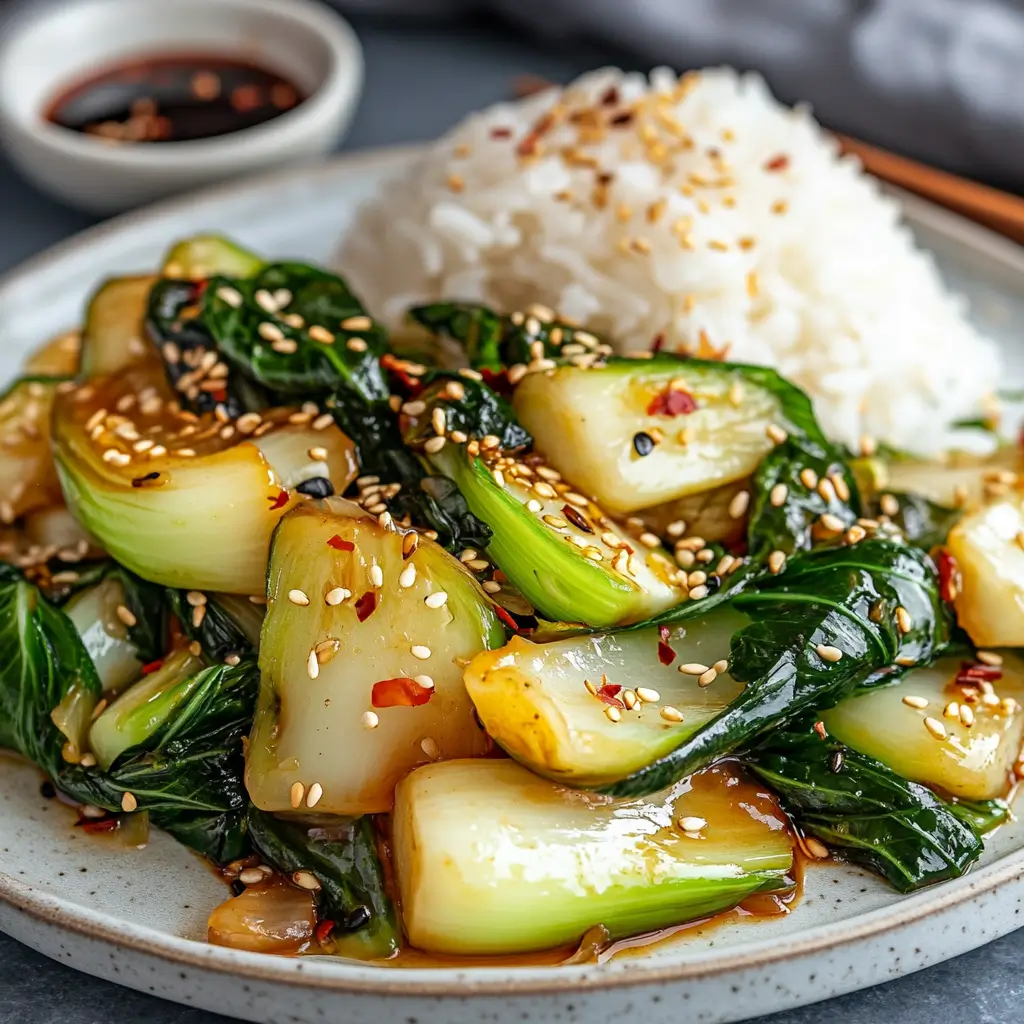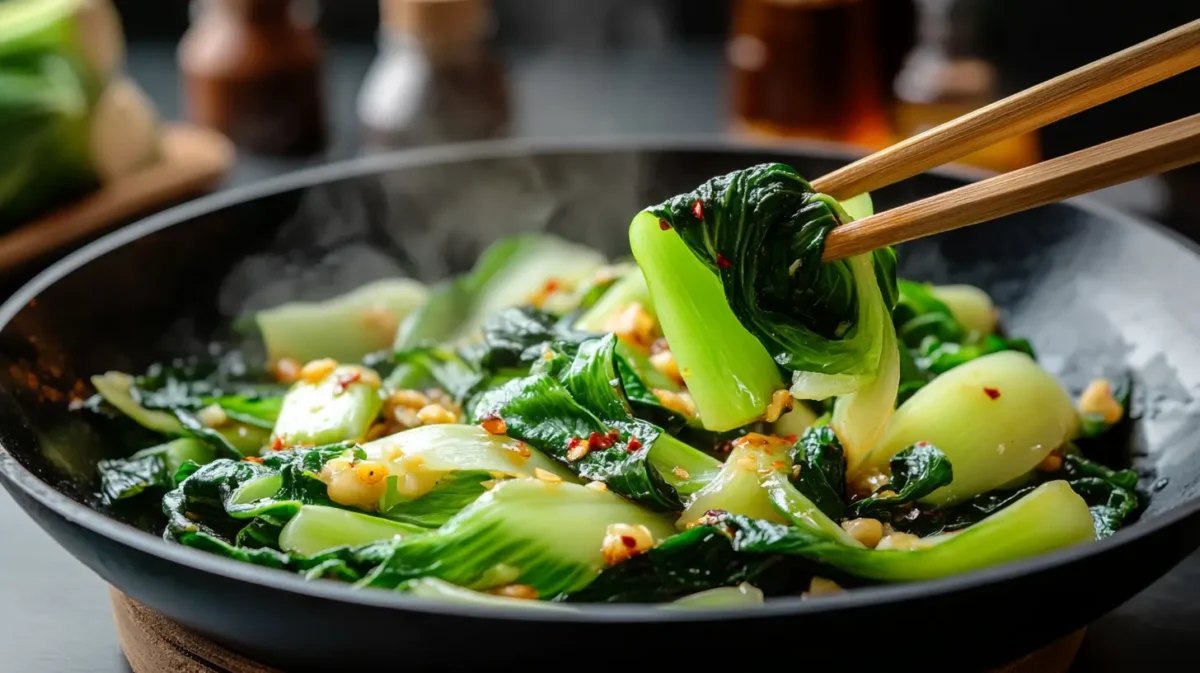Bok Choy Stir Fry
Stir-frying bok choy is one of the easiest and most delicious ways to enjoy this nutrient-packed leafy green. Whether you’re cooking a quick weeknight dinner or meal-prepping for the week, this bok choy stir fry recipe will become a staple in your kitchen. In this guide, you’ll learn how to prepare bok choy properly, the best ingredients to pair with it, and expert tips to achieve that perfect crisp-tender texture.
Let’s dive into everything you need to know to make the best bok choy stir fry at home!
Table of Contents
Ingredients & Tools You Need for Bok Choy Stir Fry
Essential Ingredients
- Bok Choy (baby bok choy or regular)
- Garlic (minced for an aromatic base)
- Ginger (adds a warm, spicy kick)
- Soy Sauce (or tamari for a gluten-free option)
- Sesame Oil (enhances flavor with nutty richness)
- Vegetable or Peanut Oil (for stir-frying at high heat)
- Red Pepper Flakes or Chili Paste (optional for heat)
- Oyster Sauce (for umami depth)
- Salt & Pepper (to taste)
Kitchen Tools
- Wok or Large Skillet (ensures even cooking)
- Sharp Knife (for proper bok choy prep)
- Tongs or Spatula (to toss ingredients quickly)
How to Prep Bok Choy for Stir Fry
Proper preparation ensures your Bok Choy Stir Fry turns out fresh and flavorful.
Step 1: Choose the Right Bok Choy
- Baby bok choy is tender and slightly sweet.
- Regular bok choy has a stronger, slightly peppery taste.
Step 2: Clean Thoroughly
- Separate the leaves from the stems.
- Rinse under cold running water to remove dirt trapped in the stalks.
- Tip: Soak bok choy in a bowl of cold water for 5 minutes to remove any hidden grit.
Step 3: Chop Accordingly
- For baby bok choy: Slice in half or quarters.
- For regular bok choy: Chop stems into bite-sized pieces and keep leaves whole or roughly chopped.

Step-by-Step: Cooking the Perfect Bok Choy Stir Fry
Mastering the perfect bok choy stir fry comes down to using the right technique and timing. Follow these detailed steps to achieve a crisp, flavorful, and restaurant-quality stir fry at home.
Step 1: Heat Your Wok or Skillet Properly
- Heat a large wok or skillet over medium-high to high heat for about 1 minute before adding oil.
- Once the pan is hot, add 1 tablespoon of vegetable oil (peanut oil, avocado oil, or canola oil work well for high-heat cooking).
- Swirl the oil around the pan to coat the surface evenly.
- Why? Preheating prevents sticking and ensures even cooking.
Pro Tip: A properly heated wok ensures that bok choy gets that signature “wok hei” (the smoky, seared flavor).
Step 2: Sauté Aromatics for Maximum Flavor
- Add 1 tablespoon of minced garlic and 1 teaspoon of minced ginger to the hot oil.
- Stir quickly for 30-45 seconds until fragrant.
- If you like heat, add ½ teaspoon of red pepper flakes or 1 teaspoon of chili paste at this stage.
Pro Tip: Don’t let the garlic burn! Stir constantly to prevent bitterness.
Step 3: Add Bok Choy Stems First
- Separate the stems from the leaves (stems take longer to cook).
- Add the chopped bok choy stems to the pan and stir-fry for 2-3 minutes until they start to soften.
- If using baby bok choy, cut them in half and cook the thicker base first.
Why? Stems have more moisture and need extra time to become tender.
Step 4: Toss in the Bok Choy Leaves
- Once the stems are slightly softened, add the bok choy leaves to the wok.
- Stir-fry for another 1-2 minutes until the leaves are just wilted but still bright green.
Pro Tip: Don’t overcook! Bok choy should be slightly crunchy, not mushy.
Step 5: Season and Enhance Flavor
- Add your sauces:
- 1 tablespoon soy sauce (or tamari for gluten-free)
- 1 tablespoon oyster sauce (optional, adds umami)
- 1 teaspoon sesame oil (for a rich, nutty aroma)
- Toss everything well to coat. Stir for 30 seconds so the flavors combine.
Alternative Sauces: Hoisin sauce, fish sauce, or a splash of rice vinegar can add unique flavors.
Step 6: Finish with a Garnish & Serve
- Remove from heat and immediately transfer to a serving dish.
- Sprinkle with sesame seeds and a dash of freshly ground black pepper.
- Serve hot with steamed rice, noodles, or a protein of choice.
Pro Tip: If you like extra crunch, top with crushed peanuts or fried shallots!
Bonus: Add Protein for a Full Meal

You can easily turn your Bok Choy Stir Fry into a balanced meal by adding protein:
| Protein | When to Add | Cooking Tip |
|---|---|---|
| Tofu | Before bok choy stems | Pan-fry until golden, then remove and add back at the end |
| Chicken | Before aromatics | Cook until no longer pink before adding bok choy |
| Shrimp | After garlic & ginger | Cooks in 2-3 minutes, remove before bok choy, then add back |
| Beef | Before bok choy stems | Thinly slice and cook quickly to avoid toughness |
Final Pro Tips for the Best Bok Choy Stir Fry
Use High Heat – Keeps bok choy crisp and prevents sogginess.
Don’t Overcrowd – Stir-fry in batches if necessary. Too much bok choy in the pan will steam instead of sear.
Serve Immediately – Bok choy tastes best fresh and hot.
Now you’re ready to make the perfect bok choy stir fry at home! Enjoy it as a quick side dish or turn it into a hearty meal by adding your favorite protein.
What Does Bok Choy Pair Well With?
Bok choy is a versatile, mild-flavored vegetable that pairs well with a variety of ingredients, making it a staple in Asian and fusion cuisine. Whether you’re stir-frying, steaming, or adding it to soups, bok choy complements proteins, grains, sauces, and seasonings exceptionally well.
1. Best Proteins to Pair with Bok Choy
Bok choy’s slightly sweet, peppery flavor balances well with different proteins, whether plant-based or meat-based.
| Protein | Why It Works with Bok Choy | Best Cooking Method |
|---|---|---|
| Chicken | Mild taste complements bok choy’s slight bitterness | Stir-fry, grilled, roasted |
| Beef | Rich and hearty, pairs well with bok choy’s crunch | Stir-fry, beef broth soup |
| Pork | Sweet, juicy pork enhances bok choy’s delicate flavor | Stir-fry, braised dishes |
| Shrimp | Light, slightly sweet seafood flavor works well with bok choy’s crisp texture | Stir-fry, soups, garlic butter shrimp |
| Tofu | Absorbs sauces well and balances bok choy’s crunch | Stir-fry, braised, grilled |
| Eggs | Soft scrambled eggs complement bok choy’s crispy stems | Stir-fry, egg drop soup |
Pro Tip: If adding protein, cook it first, remove it from the pan, then stir-fry the bok choy and return the protein at the end. This prevents overcooking.
2. Best Grains & Noodles to Serve with Bok Choy
Bok choy’s light texture pairs well with grains and noodles that absorb flavorful sauces.
| Grains/Noodles | How It Complements Bok Choy | Best Dishes |
|---|---|---|
| Steamed White Rice | Absorbs bok choy’s sauce | Side dish, rice bowls |
| Brown Rice | Nutty, chewy texture contrasts with bok choy’s crispness | Stir-fry, rice bowls |
| Jasmine Rice | Aromatic and fluffy, pairs well with stir-fried bok choy | Side for Asian dishes |
| Lo Mein Noodles | Soft noodles contrast with crunchy bok choy | Stir-fry, noodle bowls |
| Ramen Noodles | Bok choy adds freshness to rich ramen broth | Ramen soup, stir-fried ramen |
| Rice Noodles | Light and gluten-free, soaks up sauces well | Stir-fry, noodle soups |
Pro Tip: Add Bok Choy Stir Fry at the last stage of cooking when making noodle soups to maintain its fresh texture.

3. Best Sauces & Seasonings for Bok Choy
Bok choy absorbs flavors well, making it a great match for different sauces and seasonings.
| Sauce/Seasoning | Flavor Profile | Best Dishes |
|---|---|---|
| Soy Sauce | Savory, salty, umami-rich | Stir-fry, dipping sauce |
| Oyster Sauce | Deep, rich umami flavor | Stir-fry, braised dishes |
| Hoisin Sauce | Sweet, tangy, thick texture | Stir-fry, marinades |
| Sesame Oil | Nutty, aromatic | Stir-fry, salads |
| Sriracha or Chili Garlic Sauce | Spicy and slightly sweet | Stir-fry, dipping sauce |
| Miso Paste | Fermented, umami-packed | Soups, marinades |
| Rice Vinegar | Light, tangy acidity | Stir-fry, salads |
| Ginger & Garlic | Adds warmth and depth | Stir-fry, soups, marinades |
Pro Tip: Mix soy sauce + oyster sauce + sesame oil for a well-balanced bok choy stir-fry sauce.
4. Other Vegetables That Pair Well with Bok Choy
Bok choy blends beautifully with other vegetables to create balanced stir-fries and side dishes.
| Vegetable | Why It Works with Bok Choy | Best Cooking Method |
|---|---|---|
| Carrots | Adds natural sweetness and color contrast | Stir-fry, soups |
| Mushrooms | Earthy flavor balances bok choy’s mild bitterness | Stir-fry, soups |
| Bell Peppers | Sweet and slightly crunchy, pairs well with bok choy’s soft leaves | Stir-fry |
| Broccoli | Adds more texture and fiber | Stir-fry, steamed dishes |
| Snap Peas | Sweet, crisp peas complement bok choy’s flavor | Stir-fry, salads |
| Bean Sprouts | Light, fresh, slightly nutty | Stir-fry, noodle soups |
Pro Tip: Mix bok choy with mushrooms and garlic for a classic Chinese-style stir-fry.
5. Best Cooking Oils for Bok Choy Stir Fry
Choosing the right oil affects the flavor and texture of bok choy stir fry.
| Oil Type | Flavor Profile | Best For |
|---|---|---|
| Vegetable Oil | Neutral flavor, high smoke point | Stir-frying |
| Peanut Oil | Nutty aroma, high heat tolerance | Asian stir-fries |
| Sesame Oil | Rich, nutty, aromatic | Drizzling after cooking |
| Avocado Oil | Mild, buttery, high smoke point | Stir-frying, roasting |
Pro Tip: Use vegetable or peanut oil for stir-frying, and drizzle sesame oil at the end for extra flavor.
Final Thoughts: The Best Flavor Pairings for Bok Choy
For a perfectly balanced bok choy dish, combine:
A protein (chicken, beef, shrimp, tofu)
A grain (rice, noodles)
A sauce (soy sauce, sesame oil, oyster sauce)
Another vegetable (carrots, mushrooms, bell peppers)
This simple formula makes bok choy stir fry delicious, nutritious, and easy to customize!
Which Part of Bok Choy Do You Eat?
Good news! You can eat both the leaves and stems of bok choy.
| Part of Bok Choy | How It Tastes | Best Way to Cook |
|---|---|---|
| Leaves | Mild, slightly sweet | Stir-fry, soups, raw in salads |
| Stems | Crunchy, slightly peppery | Stir-fry, braised, grilled |
How Long Should You Soak Bok Choy?
Soaking bok choy helps remove dirt and grit. Follow these steps:
- Fill a large bowl with cold water.
- Separate the bok choy leaves.
- Submerge them for 5 minutes, swishing occasionally.
- Drain and rinse under running water before cooking.
Common Mistakes to Avoid When Cooking Bok Choy Stir Fry
1. Overcrowding the Pan
- Bok choy releases water as it cooks. Stir-fry in small batches to prevent steaming.
2. Overcooking
- Leaves cook faster than stems. Add them last to keep the stir fry crisp.
3. Using Too Much Oil
- Bok choy absorbs oil quickly. Stick to 1-2 tablespoons to avoid a greasy dish.
FAQs About Bok Choy Stir Fry
How to prep bok choy for stir fry?
Wash thoroughly, separate stems and leaves, chop into bite-sized pieces, and soak for 5 minutes if needed.
What does bok choy pair well with?
It pairs well with proteins like chicken, beef, shrimp, and tofu, as well as grains like rice and noodles.
Which part of bok choy do you eat?
Both the stems and leaves are edible. The stems are crunchy, while the leaves are tender.
How long should you soak bok choy?
Soak it in cold water for 5 minutes to remove dirt and grit before cooking.
Conclusion
Bok choy stir fry is a quick, healthy, and flavorful dish that’s perfect for any meal. Whether you serve it as a side dish or a main course with rice and protein, it’s guaranteed to be a crowd-pleaser. Now that you know how to prep, cook, and pair bok choy, it’s time to bring this delicious recipe to life in your kitchen.
Looking for more delicious stir-fry ideas? Check out our best recipes here!
